Sander Dieleman
Imagen 3
Aug 13, 2024Abstract:We introduce Imagen 3, a latent diffusion model that generates high quality images from text prompts. We describe our quality and responsibility evaluations. Imagen 3 is preferred over other state-of-the-art (SOTA) models at the time of evaluation. In addition, we discuss issues around safety and representation, as well as methods we used to minimize the potential harm of our models.
The NeurIPS 2023 Machine Learning for Audio Workshop: Affective Audio Benchmarks and Novel Data
Mar 21, 2024



Abstract:The NeurIPS 2023 Machine Learning for Audio Workshop brings together machine learning (ML) experts from various audio domains. There are several valuable audio-driven ML tasks, from speech emotion recognition to audio event detection, but the community is sparse compared to other ML areas, e.g., computer vision or natural language processing. A major limitation with audio is the available data; with audio being a time-dependent modality, high-quality data collection is time-consuming and costly, making it challenging for academic groups to apply their often state-of-the-art strategies to a larger, more generalizable dataset. In this short white paper, to encourage researchers with limited access to large-datasets, the organizers first outline several open-source datasets that are available to the community, and for the duration of the workshop are making several propriety datasets available. Namely, three vocal datasets, Hume-Prosody, Hume-VocalBurst, an acted emotional speech dataset Modulate-Sonata, and an in-game streamer dataset Modulate-Stream. We outline the current baselines on these datasets but encourage researchers from across audio to utilize them outside of the initial baseline tasks.
Reduce, Reuse, Recycle: Compositional Generation with Energy-Based Diffusion Models and MCMC
Feb 22, 2023



Abstract:Since their introduction, diffusion models have quickly become the prevailing approach to generative modeling in many domains. They can be interpreted as learning the gradients of a time-varying sequence of log-probability density functions. This interpretation has motivated classifier-based and classifier-free guidance as methods for post-hoc control of diffusion models. In this work, we build upon these ideas using the score-based interpretation of diffusion models, and explore alternative ways to condition, modify, and reuse diffusion models for tasks involving compositional generation and guidance. In particular, we investigate why certain types of composition fail using current techniques and present a number of solutions. We conclude that the sampler (not the model) is responsible for this failure and propose new samplers, inspired by MCMC, which enable successful compositional generation. Further, we propose an energy-based parameterization of diffusion models which enables the use of new compositional operators and more sophisticated, Metropolis-corrected samplers. Intriguingly we find these samplers lead to notable improvements in compositional generation across a wide set of problems such as classifier-guided ImageNet modeling and compositional text-to-image generation.
Continuous diffusion for categorical data
Dec 15, 2022



Abstract:Diffusion models have quickly become the go-to paradigm for generative modelling of perceptual signals (such as images and sound) through iterative refinement. Their success hinges on the fact that the underlying physical phenomena are continuous. For inherently discrete and categorical data such as language, various diffusion-inspired alternatives have been proposed. However, the continuous nature of diffusion models conveys many benefits, and in this work we endeavour to preserve it. We propose CDCD, a framework for modelling categorical data with diffusion models that are continuous both in time and input space. We demonstrate its efficacy on several language modelling tasks.
Self-conditioned Embedding Diffusion for Text Generation
Nov 08, 2022Abstract:Can continuous diffusion models bring the same performance breakthrough on natural language they did for image generation? To circumvent the discrete nature of text data, we can simply project tokens in a continuous space of embeddings, as is standard in language modeling. We propose Self-conditioned Embedding Diffusion, a continuous diffusion mechanism that operates on token embeddings and allows to learn flexible and scalable diffusion models for both conditional and unconditional text generation. Through qualitative and quantitative evaluation, we show that our text diffusion models generate samples comparable with those produced by standard autoregressive language models - while being in theory more efficient on accelerator hardware at inference time. Our work paves the way for scaling up diffusion models for text, similarly to autoregressive models, and for improving performance with recent refinements to continuous diffusion.
Categorical SDEs with Simplex Diffusion
Oct 26, 2022Abstract:Diffusion models typically operate in the standard framework of generative modelling by producing continuously-valued datapoints. To this end, they rely on a progressive Gaussian smoothing of the original data distribution, which admits an SDE interpretation involving increments of a standard Brownian motion. However, some applications such as text generation or reinforcement learning might naturally be better served by diffusing categorical-valued data, i.e., lifting the diffusion to a space of probability distributions. To this end, this short theoretical note proposes Simplex Diffusion, a means to directly diffuse datapoints located on an n-dimensional probability simplex. We show how this relates to the Dirichlet distribution on the simplex and how the analogous SDE is realized thanks to a multi-dimensional Cox-Ingersoll-Ross process (abbreviated as CIR), previously used in economics and mathematical finance. Finally, we make remarks as to the numerical implementation of trajectories of the CIR process, and discuss some limitations of our approach.
General-purpose, long-context autoregressive modeling with Perceiver AR
Feb 15, 2022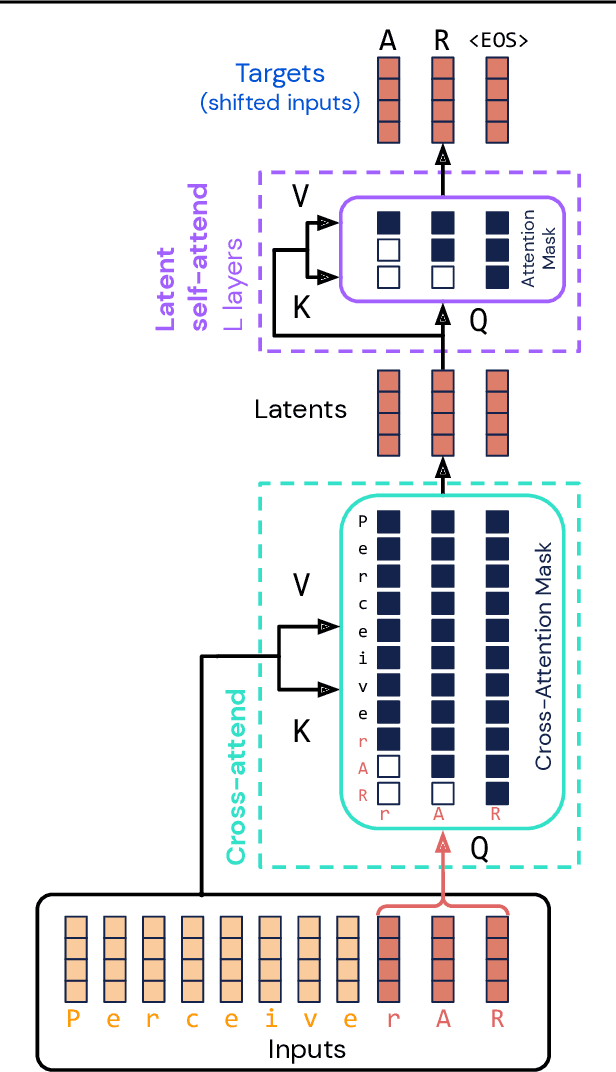
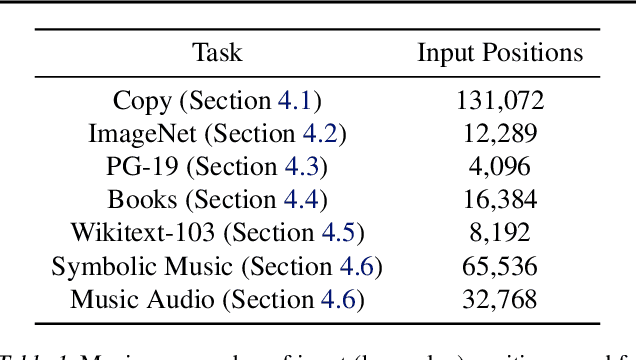
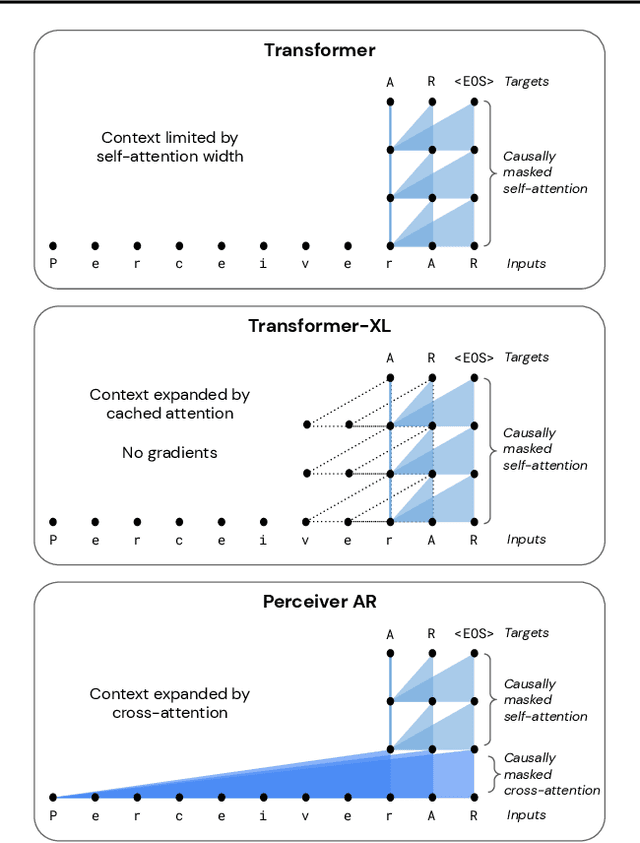

Abstract:Real-world data is high-dimensional: a book, image, or musical performance can easily contain hundreds of thousands of elements even after compression. However, the most commonly used autoregressive models, Transformers, are prohibitively expensive to scale to the number of inputs and layers needed to capture this long-range structure. We develop Perceiver AR, an autoregressive, modality-agnostic architecture which uses cross-attention to map long-range inputs to a small number of latents while also maintaining end-to-end causal masking. Perceiver AR can directly attend to over a hundred thousand tokens, enabling practical long-context density estimation without the need for hand-crafted sparsity patterns or memory mechanisms. When trained on images or music, Perceiver AR generates outputs with clear long-term coherence and structure. Our architecture also obtains state-of-the-art likelihood on long-sequence benchmarks, including 64 x 64 ImageNet images and PG-19 books.
Towards Learning Universal Audio Representations
Dec 01, 2021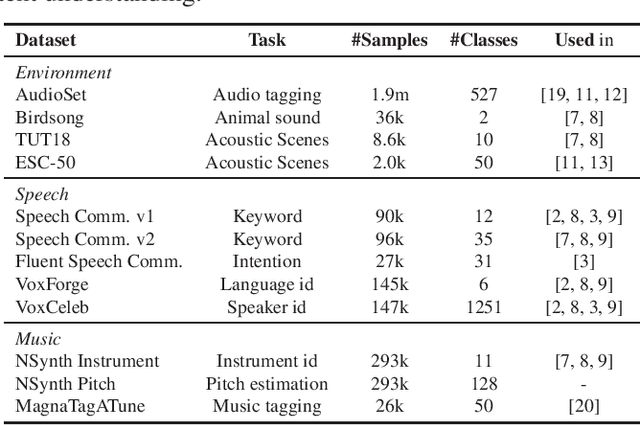
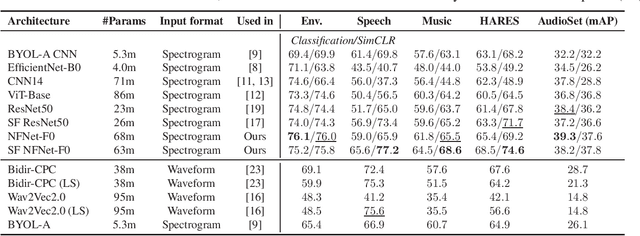

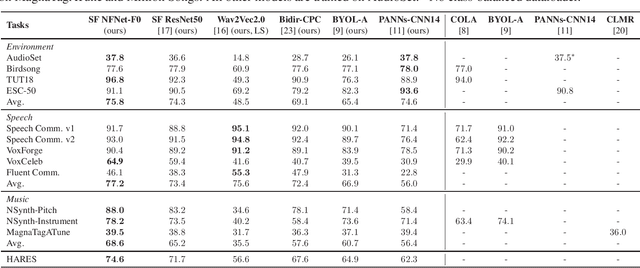
Abstract:The ability to learn universal audio representations that can solve diverse speech, music, and environment tasks can spur many applications that require general sound content understanding. In this work, we introduce a holistic audio representation evaluation suite (HARES) spanning 12 downstream tasks across audio domains and provide a thorough empirical study of recent sound representation learning systems on that benchmark. We discover that previous sound event classification or speech models do not generalize outside of their domains. We observe that more robust audio representations can be learned with the SimCLR objective; however, the model's transferability depends heavily on the model architecture. We find the Slowfast architecture is good at learning rich representations required by different domains, but its performance is affected by the normalization scheme. Based on these findings, we propose a novel normalizer-free Slowfast NFNet and achieve state-of-the-art performance across all domains.
Variable-rate discrete representation learning
Mar 10, 2021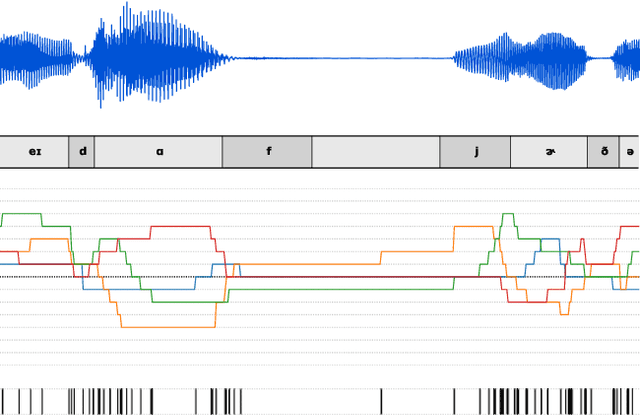
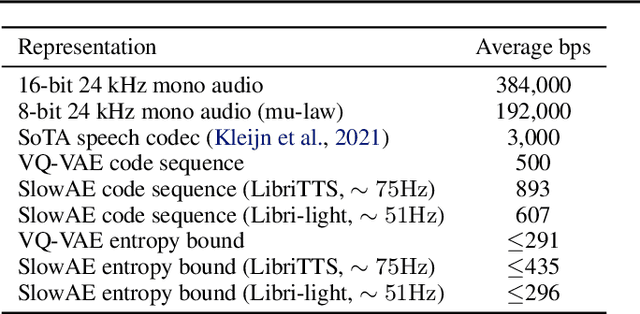
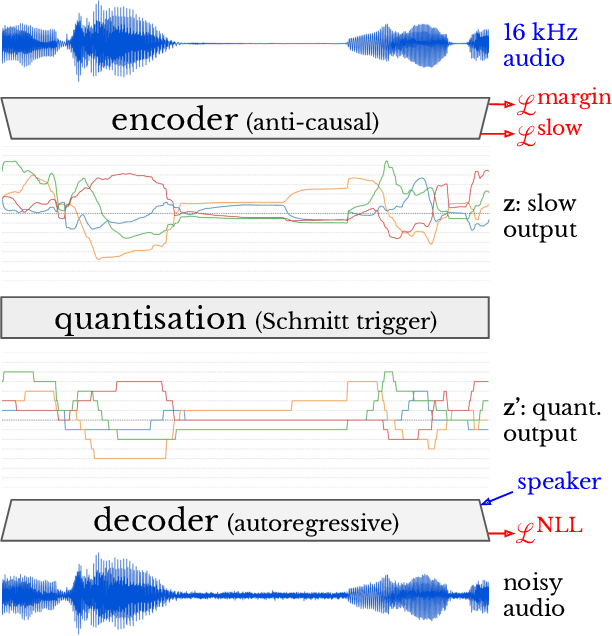
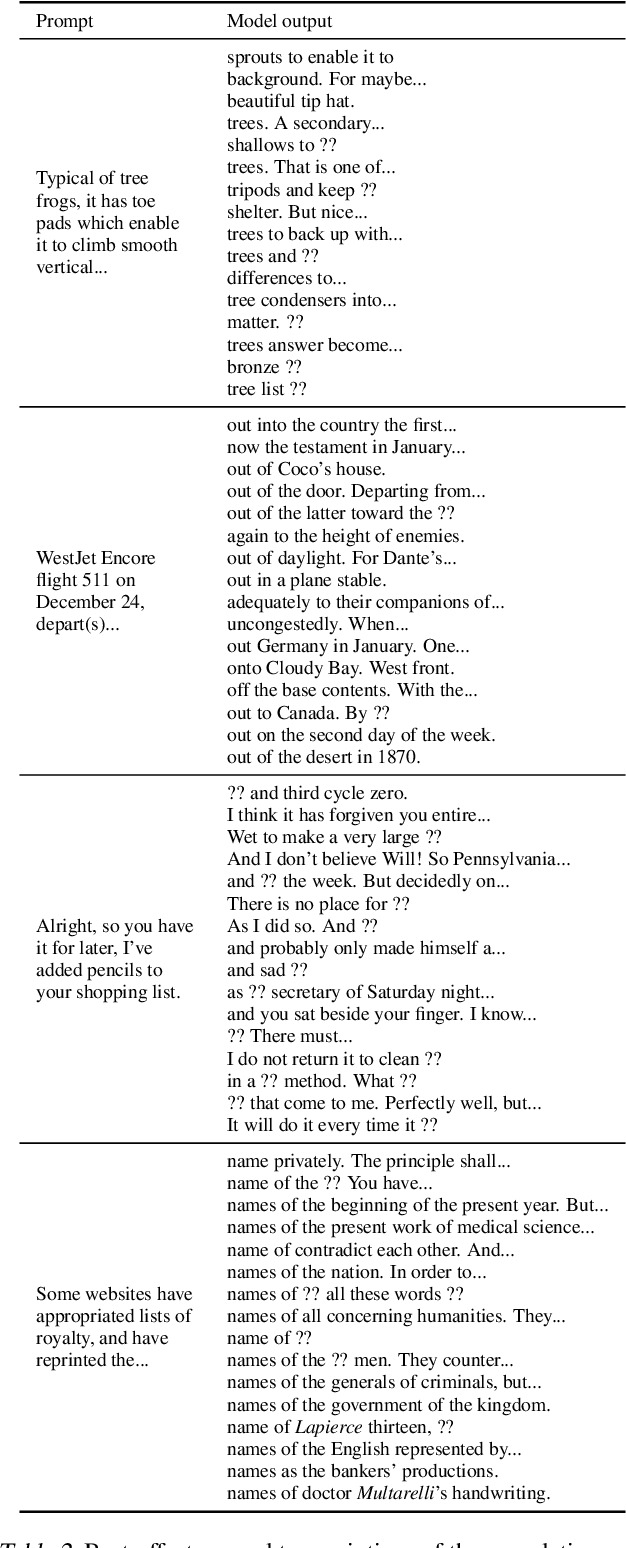
Abstract:Semantically meaningful information content in perceptual signals is usually unevenly distributed. In speech signals for example, there are often many silences, and the speed of pronunciation can vary considerably. In this work, we propose slow autoencoders (SlowAEs) for unsupervised learning of high-level variable-rate discrete representations of sequences, and apply them to speech. We show that the resulting event-based representations automatically grow or shrink depending on the density of salient information in the input signals, while still allowing for faithful signal reconstruction. We develop run-length Transformers (RLTs) for event-based representation modelling and use them to construct language models in the speech domain, which are able to generate grammatical and semantically coherent utterances and continuations.
Generating Images with Sparse Representations
Mar 05, 2021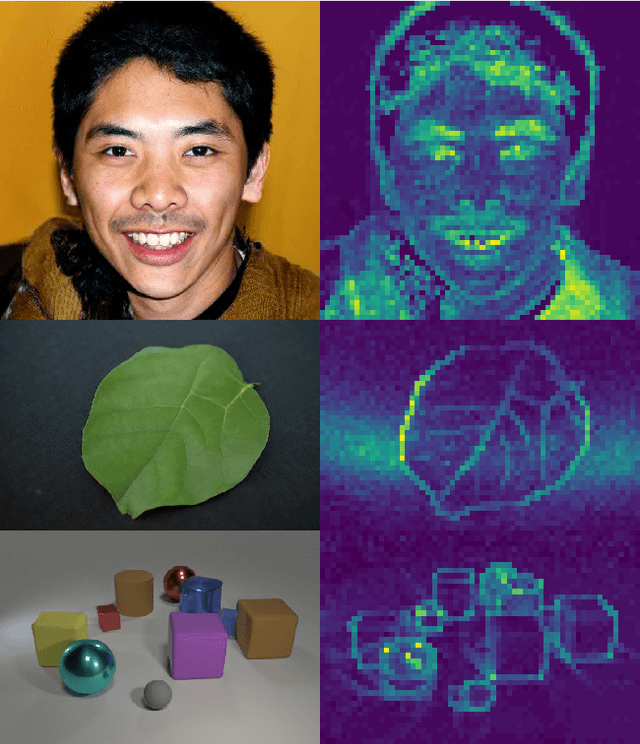
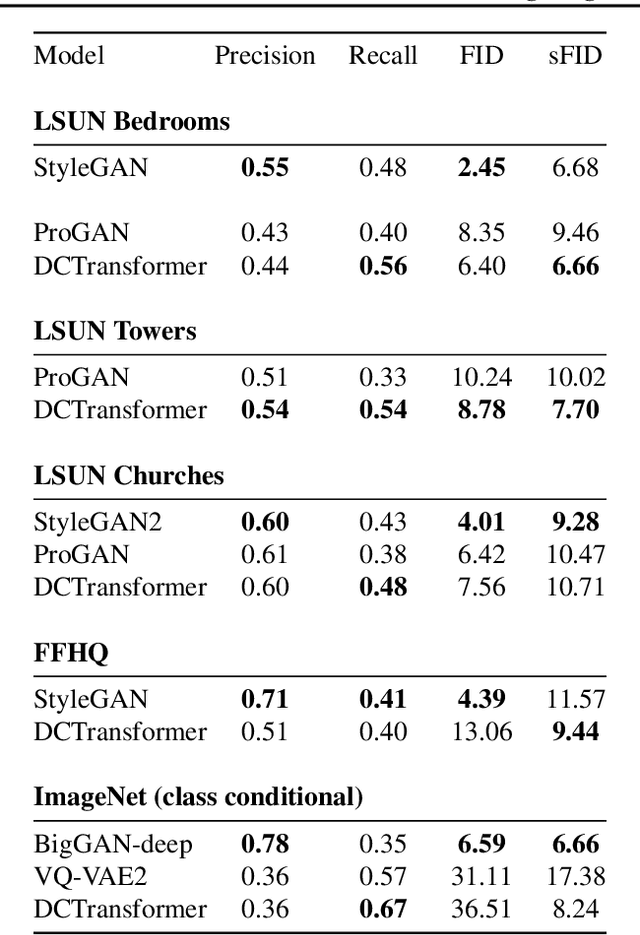
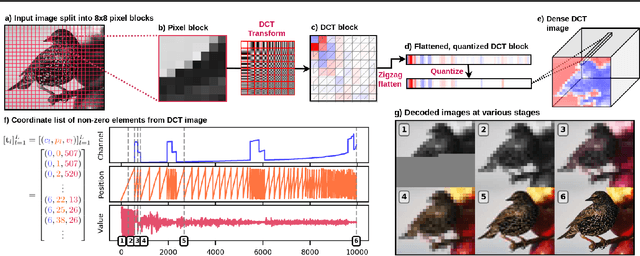
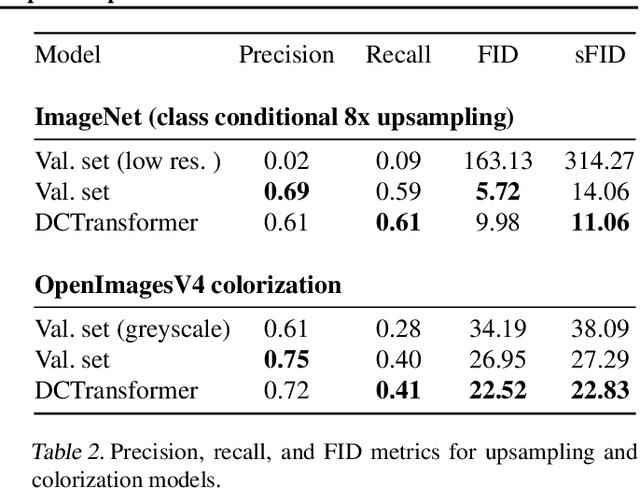
Abstract:The high dimensionality of images presents architecture and sampling-efficiency challenges for likelihood-based generative models. Previous approaches such as VQ-VAE use deep autoencoders to obtain compact representations, which are more practical as inputs for likelihood-based models. We present an alternative approach, inspired by common image compression methods like JPEG, and convert images to quantized discrete cosine transform (DCT) blocks, which are represented sparsely as a sequence of DCT channel, spatial location, and DCT coefficient triples. We propose a Transformer-based autoregressive architecture, which is trained to sequentially predict the conditional distribution of the next element in such sequences, and which scales effectively to high resolution images. On a range of image datasets, we demonstrate that our approach can generate high quality, diverse images, with sample metric scores competitive with state of the art methods. We additionally show that simple modifications to our method yield effective image colorization and super-resolution models.
 Add to Chrome
Add to Chrome Add to Firefox
Add to Firefox Add to Edge
Add to Edge